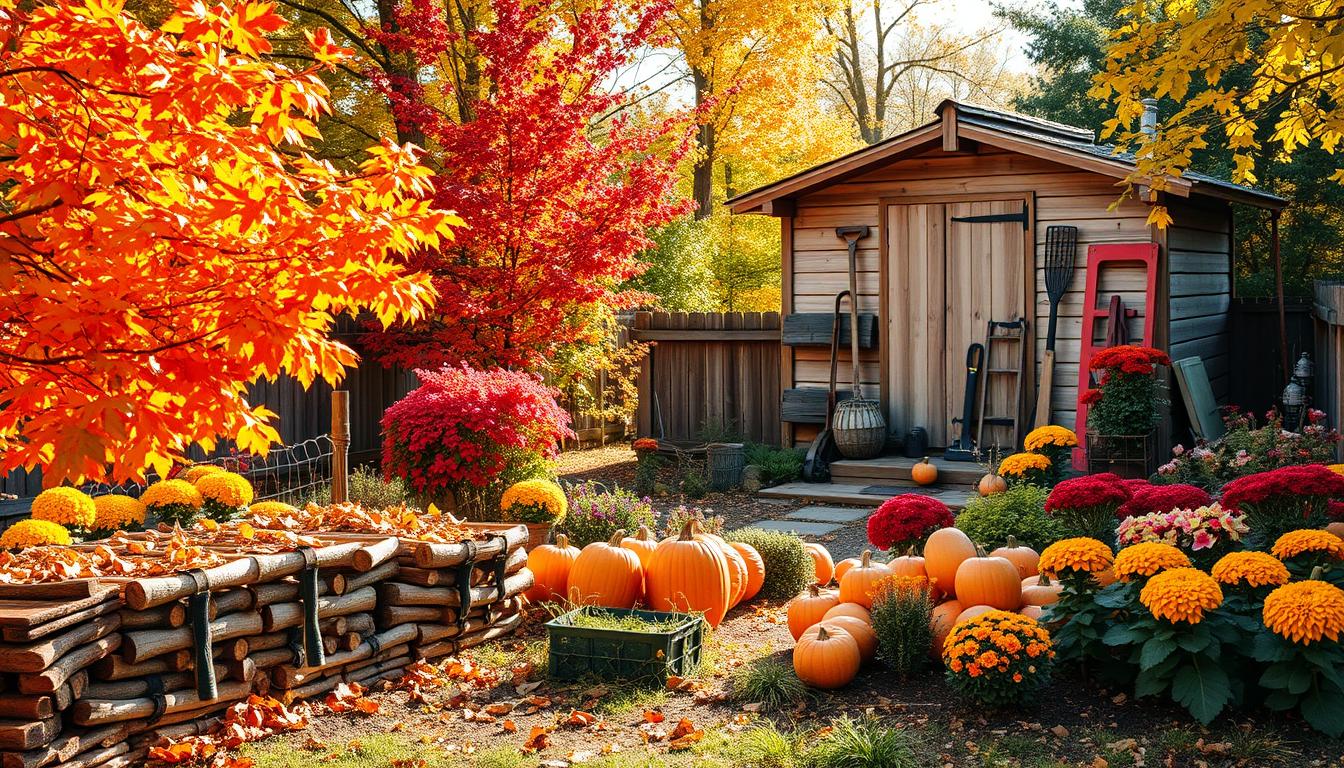As autumn arrives, it’s time to get my garden ready for winter. I need to care for my trees, shrubs, and perennials. I also have to clean up my veggie garden and winterize my lawn.
Doing these tasks now will give me more time in spring. I won’t be stuck cleaning up or searching for tools.
Key Takeaways
- Prepare your garden for the coming winter by tackling essential fall tasks like caring for trees, shrubs, and perennials.
- Cleaning up the vegetable garden and winterizing the lawn now will save time in the spring.
- Autumn is the optimal time to plant spring-blooming bulbs like tulips and daffodils.
- Mulching garden beds and staking young trees can protect plants from winter weather.
- Maintaining bird feeders and properly disposing of diseased plants are important fall chores.
Why Autumn Garden Preparation is Crucial
As summer’s warmth turns to autumn’s cool, it’s key to get your garden ready. This prep helps plants adjust, keeps them safe from pests and diseases, and gets them ready for cool-season planting.
Facilitating Plant Adaptation
Plants change a lot as they move from summer’s long days to autumn’s short, cool ones. Preparing your garden helps them adapt better. You might need to adjust watering, prune, and add soil amendments to help roots grow and get nutrients.
Protecting Plants from Pests and Diseases
Autumn’s weather is perfect for pests and diseases. But, you can fight back. By removing sick plants, using organic pest control, and improving air flow, you can keep your plants safe.
Planning for Cool-Season Planting
Autumn is the best time to plan for cool-season crops. By checking your soil, adding compost, and picking the right planting times, you’ll get a great harvest of autumn and winter veggies, and a beautiful spring.
“Preparing your garden for autumn is not just about maintaining the aesthetics; it’s a proactive step to ensure the long-term health and productivity of your plants.”
Spending time on fall garden prep helps your plants adjust to autumn. It also makes your garden strong and ready for the future.
Timing Your Autumn Garden Tasks
As the seasons change, timing is key when getting your garden ready for autumn. Knowing your local climate and the first frost date helps you plan. This way, your plants will be ready for the weather changes.
Understanding Your Local Climate
In milder climates, autumn gardening is easier without harsh weather. Learn about your area’s autumn temperatures, rain, and first frost. This info helps you plan and keep your plants healthy as the weather shifts.
Creating a Task Checklist
Making a detailed fall garden checklist keeps you organized. Tasks include mulching spent plants, adding soil amendments, and protecting plants from cold. This ensures your garden stays healthy.
Timing Fall Crop Planting
Planting fall crops at the right time is crucial for a good harvest. Planting winter veggies and spring flowers in autumn lets them grow before spring. Think about what your crops need, like soil and growth time, for a successful garden.
Understanding your climate, making a checklist, and timing your planting right prepares your garden for autumn. Your garden will thrive through the changing weather.
Essential Tools for Autumn Gardening
As the leaves change color and the air gets cooler, it’s time to get ready for autumn gardening. We need the right tools to prepare our gardens for the season. From picking strong plants to getting the right soil and cleanup tools, having the right equipment is key.
Selecting Resilient Plants
Choose plants that can handle the cooler weather and changing conditions. Good options include perennials like chrysanthemums, asters, and ornamental kale. Also, cool-season annuals like pansies, violas, and snapdragons are great. These plants will add color and texture to your garden.
Soil Preparation Tools
Good soil is essential for a great autumn garden. Use a garden fork or tiller to loosen and aerate the soil. This helps with nutrient absorption and drainage. A stainless steel hand trowel is useful for planting bulbs and dividing perennials. A gardening rake is also great for removing debris and getting beds ready.
Garden Cleanup and Maintenance Tools
As the growing season ends, we need the right tools for cleanup and maintenance. Sharp bypass pruners or loppers are good for trimming back plants. A leaf blower or rake helps with fallen leaves. A wheelbarrow or leaf scoop makes moving yard waste easier. Remember to wear heavy-duty work gloves to protect your hands.
With the right tools, transitioning to the cooler months will be smooth. You’ll be ready to keep your garden thriving all year.
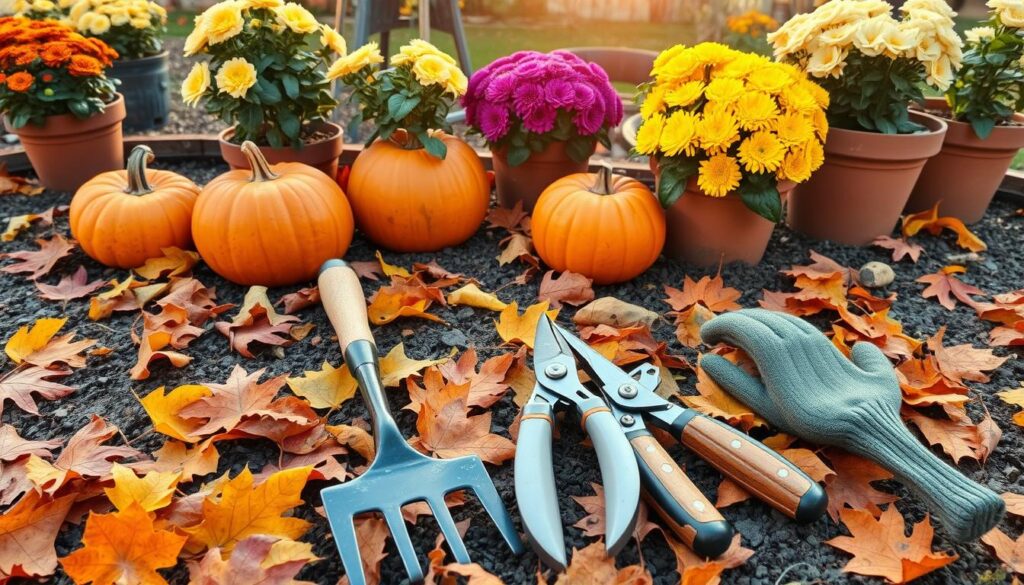
| Tool | Purpose |
|---|---|
| Garden Fork | Loosening and aerating soil |
| Hand Trowel | Planting bulbs and dividing perennials |
| Rake | Removing debris and preparing planting beds |
| Bypass Pruners | Trimming back perennials for winter |
| Leaf Blower | Efficiently moving leaf piles |
| Wheelbarrow | Transporting yard waste |
Transitioning from Summer to Autumn
As summer fades into autumn, it’s time to get your garden ready. You need to think carefully to make sure your plants do well during this change. This is key for a successful transition.
Removing Spent Summer Plants
First, check your summer plants and take out the ones that are done. Pull out or prune any dead or dying plants. This makes room for new plants and keeps your garden looking good.
It also stops diseases and pests from spreading in the cooler months.
Replenishing Soil Fertility
To get your garden ready for autumn, focus on making the soil rich. Add compost or a nitrogen-based fertilizer to give your plants what they need. This is vital for improving soil fertility for fall and helping cool-season crops grow.
Protecting Delicate Plants
When it starts to get colder, protect your sensitive plants. Use a lightweight fabric or move them to a safer spot, like a greenhouse. This protects plants in autumn and helps them adjust to the new weather.
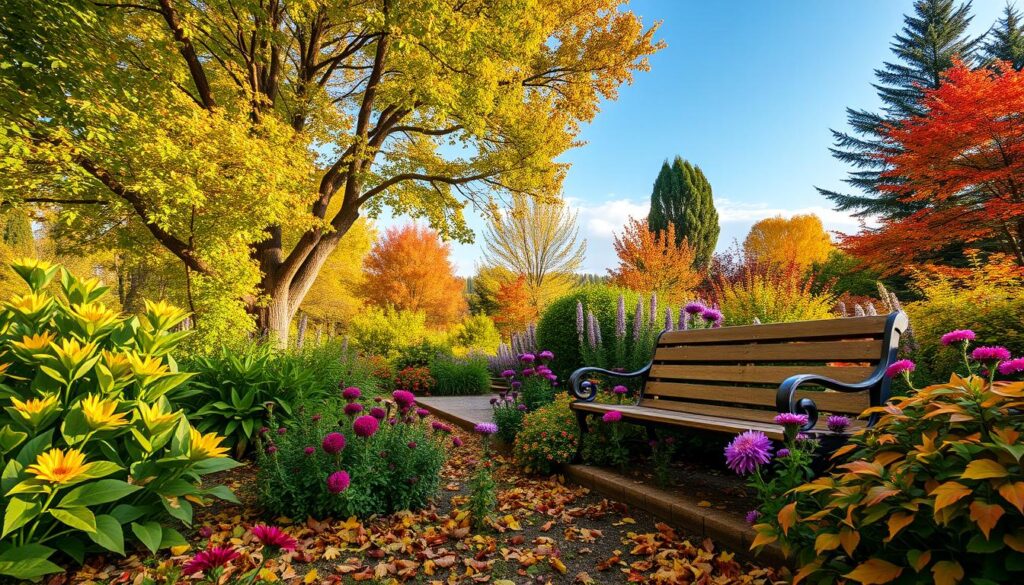
By transitioning your summer garden to fall carefully, you can make sure everything goes smoothly. Remove old plants, enrich the soil, and shield delicate ones. With some planning, your garden will flourish in the autumn and give you a great harvest.
Preparing you garden for fall
As summer ends and autumn arrives, it’s time to prepare your garden. Taking steps to get your yard ready for fall helps your plants thrive. It also prepares your garden for a great growing season next year.
Planting new trees and shrubs is key. Do this about a month before the ground freezes. This lets the roots grow strong before winter. Make sure to water these plants well to help them survive the cold.
Adding mulch around trees and shrubs is also important. It protects the roots from cold and keeps the soil moist. Now is a great time to plant bulbs like tulips and daffodils for a beautiful spring.
Keep watering your perennial gardens once a week, even when they’re dormant. This helps the roots grow. In vegetable beds, add compost, plant cover crops, and clean out old plants. This gets your garden ready for next year.
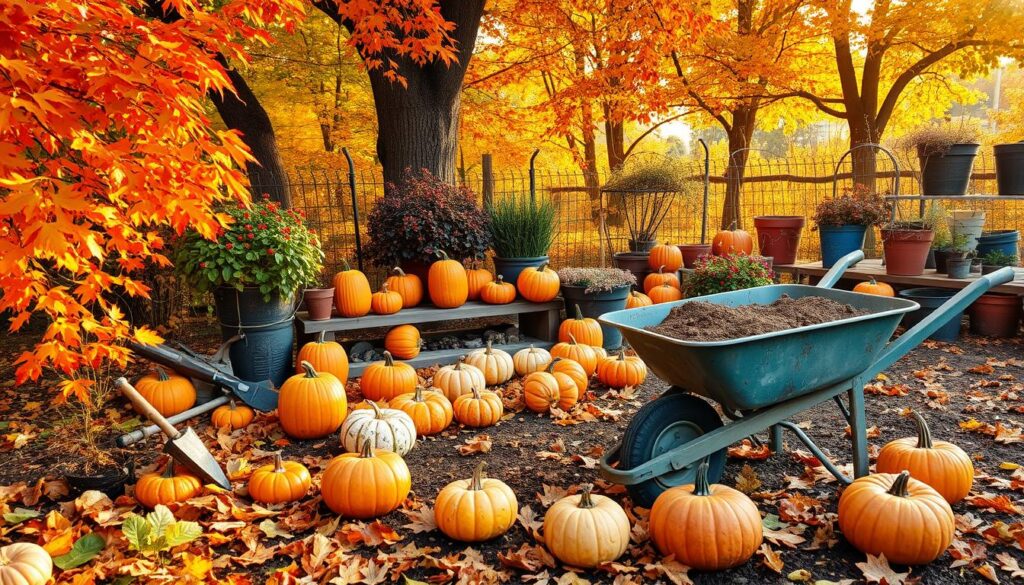
Don’t forget about your lawn. Raise your mower blade to help the grass grow deeper. This makes it stronger against winter. Also, clean up fallen leaves to prevent them from killing your grass. Aerate your lawn every year, and every 2-3 years for the rest.
Finally, clean and maintain your gardening tools. Sharpen blades, oil metal parts, and store hoses and irrigation lines before the first freeze. By doing these tasks, you’ll have a healthy garden ready for spring.
Garden Debris and Fallen Leaves
Autumn brings vibrant colors and natural cycles to our gardens. But, it also means more garden debris and fallen leaves. Instead of seeing them as a problem, gardeners can turn them into valuable resources.
Composting for Nutrient-Rich Soil
Composting is a great way to handle garden debris and leaves. Leaves are full of carbon, and other plant materials have nitrogen. By mixing them and letting them break down, you get compost that feeds your soil and helps plants grow.
- Leaves have twice the minerals of manure, making them great for compost.
- Shredding leaves helps microbes break them down faster.
- Adding slow-release nitrogen fertilizer helps the composting process and keeps nitrogen levels up.
Using Leaves as Mulch or Insulation
If composting isn’t your first choice, use leaves as mulch or insulation. Leaf litter protects plants and keeps soil moist in the cold months.
- Put a 6-inch layer of whole or shredded leaves around plants to protect them from winter.
- Mixing shredded leaves into the soil attracts earthworms and beneficial organisms.
- Leaf mold, the decomposed leaves, is a great natural mulch that holds water and gives nutrients.
By using fallen leaves and garden debris, you can make your garden thrive. Turn them into compost or use them to protect your plants. This way, your garden will flourish all year round.
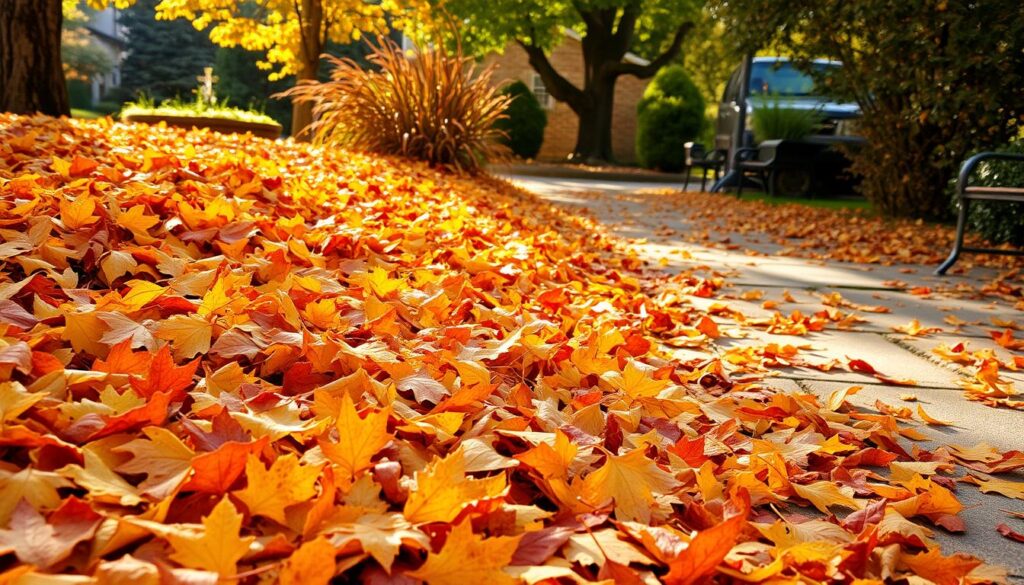
“Leaves are a fabulous source of carbon to balance the nitrogen in a compost pile.”
Conclusion
Preparing my garden for autumn is key to a successful outdoor space in the cooler months. I focus on helping plants adapt and protecting them from pests. I also plan for planting in the cooler seasons and manage garden debris.
By doing these tasks, my garden will thrive in the spring and summer. With the right preparation, my garden will be vibrant all year.
This autumn, I’ll work on maintaining the soil’s pH and using weed control. I’ll also sow cover crops and clean up the garden. Harvesting seeds and keeping rain barrels in good shape will help my garden next year.
Investing time and effort in autumn preparation is crucial for my garden’s health. By keeping up with fall gardening tasks, I’ll have a lush and fruitful outdoor space for years to come.
FAQ
Q: Why is preparing my garden for autumn important?
A: Preparing your garden for autumn is key for several reasons. It helps plants adjust to cooler temperatures and shorter days. It also protects them from pests and diseases. Plus, it prepares your garden for cool-season planting, ensuring a good harvest and a beautiful spring.
Q: When is the best time to start my autumn garden preparation?
A: Timing is everything when getting your garden ready for autumn. Knowing your local climate and the first frost date helps you plan. This ensures your plants are ready for the weather changes.
Q: What tools do I need for my autumn gardening tasks?
A: Choosing the right tools is vital for autumn garden prep. You’ll need plants that can handle cooler weather and tools to loosen soil. Also, have tools for cleanup and maintenance to keep your garden tidy.
Q: What are the key steps in transitioning my garden from summer to autumn?
A: Transitioning your garden from summer to autumn involves several steps. First, remove any spent plants to make room for new ones. Then, add organic matter to the soil to feed your plants. Finally, protect sensitive plants from the cold by covering them or moving them.
Q: How can I use garden debris and fallen leaves in my autumn garden preparation?
A: Don’t throw away garden debris and fallen leaves. Instead, compost them to make nutrient-rich soil. Or, use them as a natural mulch to protect plants from winter cold.


